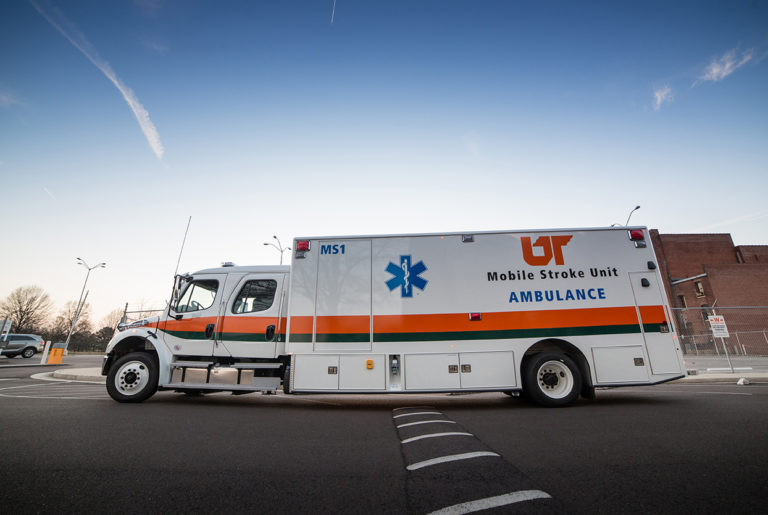
A little over four years ago, I wrote about a mobile Stroke unit being launched out of a Houston hospital. The idea was to speed up diagnosis and treatment of Stroke patients.
I didn’t think much of the idea then and nothing that has transpired in the four years since has change my mind.
Here is the original article for those who care to read or reread it. Stroke Job.
Here is a quote from the article I cited in the post,
Grotta, co-principal investigator of the study, said: “We know we can speed up treatment but we don’t know how much that speed will affect recovery.” .“We really don’t have data on how receiving tPA within the first hour after symptoms start affects patient outcomes, including the amount of disability. This study will help us determine how much more helpful it is to receive tPA within that first hour.”
Apparently we have an answer now. It doesn’t improve outcomes.
They’re a hot idea and spreading rapidly: Since the U.S.’ first mobile stroke ambulance hit the streets in Houston in 2014, at least a dozen have followed in other cities, with more planned.1 There’s just one catch: There’s no data that shows they actually improve patient outcomes. And given their cost, that’s leading an increasing number of docs and other emergency leaders to question whether they really represent the best use of limited dollars.
So, here is an expensive treatment/transport modality that doesn’t improve outcomes in patients. It’s likely that the money can be put into other efforts that will benefit patients.How expensive? Here is one estimate.Here’s the math: MSUs cost roughly a million bucks.2,3 “That’s what’s been quoted to us in Louisville,” says Tim Price, MD, an associate professor in the University of Louisville’s Department of Emergency Medicine who argued against MSUs in a pro/con debate at the NAEMSP’s 2018 annual meeting, “and that’s without the telemedicine piece.” Yearly operation may cost half a million to a million more.3,4That’s a million dollars for the ambulance and modifications to install a mobile CT unit. Then there are the operating costs on top of that. To try to speed up what should be an in hospital process. It still seems to be that working on in hospital issues and educating EMS providers, who really should know this by now, on Stroke recognition and notification, would be money better spent.For those who don’t come here via Facebook and haven’t seen the featured image for this post there, this is what one of the MSUs looks like,
Yeah, I’d say that would cost close to $1,000,000.00. Plus staffing costs.
The article goes on to talk about the efficacy of tPA in any setting,This may be startling to providers holding the impression that fast tPA is a wonder drug for stroke. At http://www.thennt.com/nnt/thrombolytics-for-stroke/, author David Newman, MD, overviews 12 key studies that collectively depict something much different: Only two showed clear benefit. Ten were negative, and four of those indeed had to be terminated early.11An EM physician who I’ve known for some years told me about a year ago that she was very skeptical about the entire stroke treatment paradigm. She said that her experience was that tPA was rarely given and that at that it didn’t have a great track record on reversing the signs and symptoms or restoring pre Stroke function.Which is too bad as I’m entering the age where I have to add a Stroke to the things I need to worry about.This also extends to the Mobile Stroke Units that are in operation,And whether or not tPA works for acute ischemic strokes, early data shows that even mobile stroke units intended for its early delivery just aren’t getting tPA to that many patients. Of the first 100 patients treated by Cleveland’s MSU, just 16 ultimately received tPA—5% of those for whom it was dispatched.3,7 A study of information systems around New York Presbyterian Hospital’s unit found 16 administrations in seven months.17 Calgary’s unit gave it 16 times in its first year.18 And in Houston, now site of the most comprehensive look yet at MSUs’ impact (the BEST-MSU study), a run-in phase revealed an administration rate of 1.5 a week.19
There is a lot more in the article, it’s well worth reading just for the tPA information, regardless of where it was given (or not given).
Finally, is there a role for MSUs in diagnosis and speeding treatment of Large Vessel Occlusions? Maybe. But, the number needed to treat (NNT) seems to be very high even for a diagnosis and transport only approach.
The emphasis in prehospital stroke care today lies less on smaller strokes than large-vessel occlusions. Is there a role for MSUs in identifying these and routing patients to comprehensive stroke centers for fast thrombectomies?
Some recent studies have concluded that’s feasible.22,23 But at NAEMSP Price explored some limitations to that data too. He looked specifically at the conclusions of a Cleveland piece that found the MSU “may help in early triage and shorten the time to IAT (intra-arterial therapy) for AIS (acute ischemic stroke).”24
The data on this is far less than clear and will likely remain so for some time. For that matter, even thrombectomy for LVO, as promising as it appears hasn’t fully proven itself.
Sometimes what seem like great ideas don’t pan out as hoped. The problem is getting the proponents to admit that and move on to something else.
It seems like it’s time to abandon the MSU approach and find something that will improve outcomes.
The science, it seems, is never settled.
